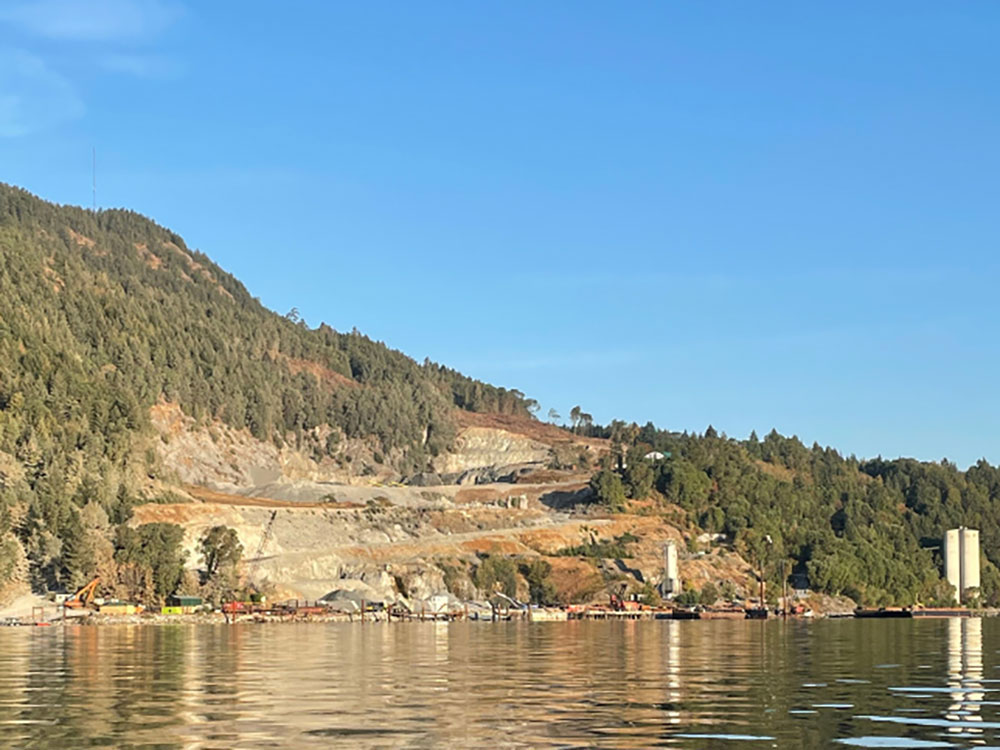A controversial proposal to expand the Bamberton quarry near Mill Bay on southern Vancouver Island may get a full environmental assessment, the British Columbia minister responsible said this week.
“I'm a bit surprised that the member believes that I'm excusing destruction when no final decision has been made,” Environment and Climate Change Strategy Minister George Heyman said in the legislature, responding to Green MLA for Saanich North and the Islands Adam Olsen.
“I take the process seriously,” Heyman said.
The Malahat Investment Corp. and Malahat Nation have proposed expanding the existing waterfront aggregate quarry on the Saanich Inlet from 39.3 hectares to 45.7 hectares and doubling its capacity to 489,000 tonnes per year. Aggregate includes sand, gravel, stone or other similar materials used in construction.
The increases are too small to automatically trigger an environmental assessment.
But after the Saanich Inlet Protection Society made a formal application in November, the Environmental Assessment Office has been considering whether the project and associated activities should be designated as reviewable.
According to the EAO, the project involves barging, storage and transportation of contaminated soils and fuel.
It prepared a draft report and opened a public comment period that will close Tuesday.
Olsen asked Heyman about the process Monday in the legislature.
“Like our ancestors, I, my relatives and our descendants rely on the Saanich Inlet to harvest our food,” said Olsen, who is a member of the Tsartlip First Nation across the inlet from the quarry. “Salmon, herring, herring eggs, cod, cod eggs, snapper, crab, clams, mussels, prawns, ducks, oysters, sea eggs, urchins, octopus, seal, seaweed, deer and many other species.”
He pointed out that a 1996 government study when the NDP was in power found the Saanich Inlet is a highly valued place. “The aesthetic, cultural, spiritual and environmental values have been diminished or degraded,” he said. “Despite the degradation, it is still a viable ecological system.”
Olsen said the government should apply the precautionary principle and do what it can to protect and restore the inlet.
Heyman answered that following the Saanich Inlet Protection Society’s request, the process is proceeding as it should.
“The EAO has gone out of its way to hear from people,” said Heyman. “It has, in fact, allowed the Saanich Inlet Protection Society, in an unprecedented manner, to participate directly in having a voice in public hearings and having input into those hearings.”
When the comment period closes, the input and knowledge about the inlet will be “applied to the determination about whether an environmental assessment should be ordered,” he said.
Olsen noted that the application “was just screaming through the process” until the community organization raised issues and got the government to pay attention and delay the decision on expanding the quarry.
“What it seems like is that this process is just an enabler of the extractive industry that is proposing to grind away a sacred mountain site and to threaten and damage all of the food sources that me and my relatives have harvested and fed our families with for generations and that we are standing up and hoping we can protect for generations to come,” Olsen said.
He accused Heyman of “excusing the destruction of the Saanich Inlet” instead of protecting it.
Heyman responded that Olsen had failed to recognize that the government made changes to the Environmental Assessment Act in 2018 and introduced a new Reviewable Projects Regulation that allowed for reviews in situations where they weren’t automatically triggered by the size of the proposal or expansion.
A production increase of 250,000 tonnes per year would have automatically triggered an assessment; the proposal is to increase production by 239,000 tonnes per year.
“We put in place a mechanism to ensure that if certain projects came close to that threshold, they had to notify the Environmental Assessment Office so consideration could be given as to whether an assessment should be ordered in a particular, specific case,” Heyman said.
“That is exactly the process that we are undertaking today. That is a process that we take very seriously.”
The EAO’s website says it prepared the draft report after a review of information from the Saanich Inlet Protection Society, Malahat Investment Corp., potentially affected Indigenous nations, and local, provincial and federal government experts.
After public comments close and the final report is completed, it goes to Heyman who will decide whether the project will need an environmental assessment. ![]()
Read more: BC Politics, Environment

















Tyee Commenting Guidelines
Comments that violate guidelines risk being deleted, and violations may result in a temporary or permanent user ban. Maintain the spirit of good conversation to stay in the discussion.
*Please note The Tyee is not a forum for spreading misinformation about COVID-19, denying its existence or minimizing its risk to public health.
Do:
Do not: